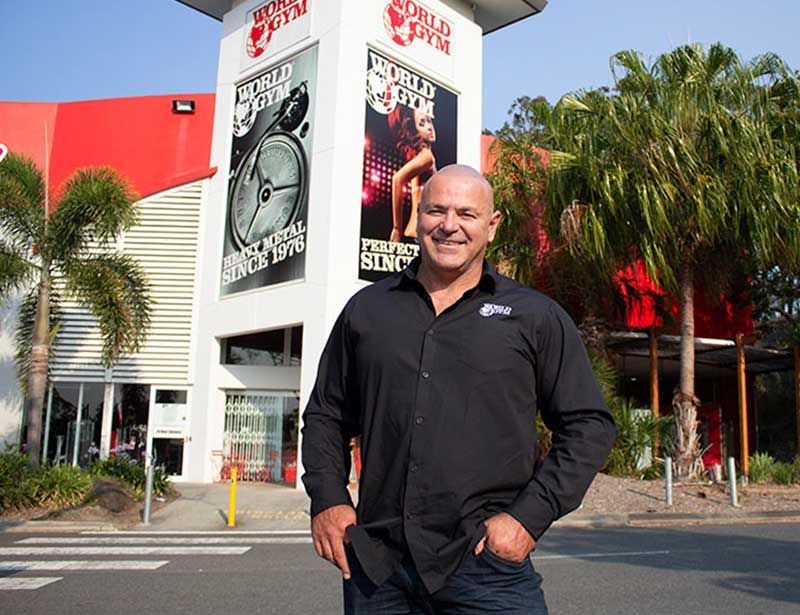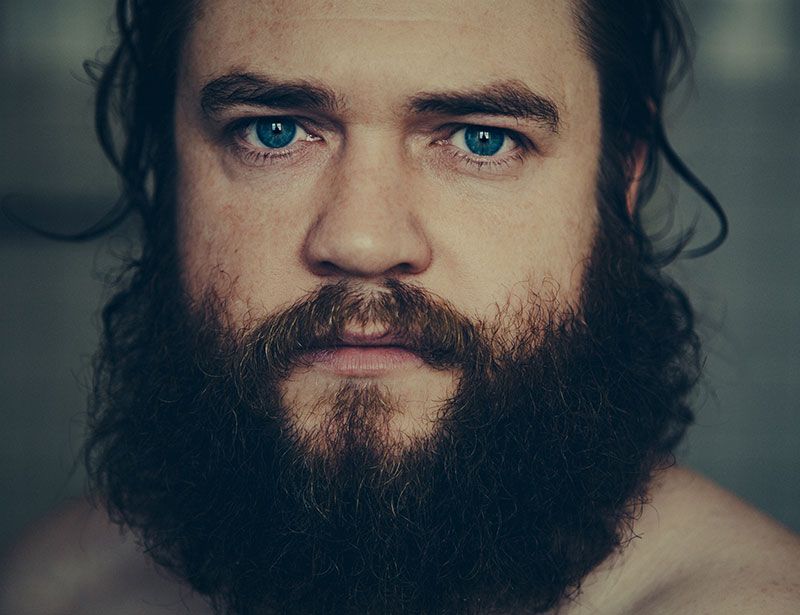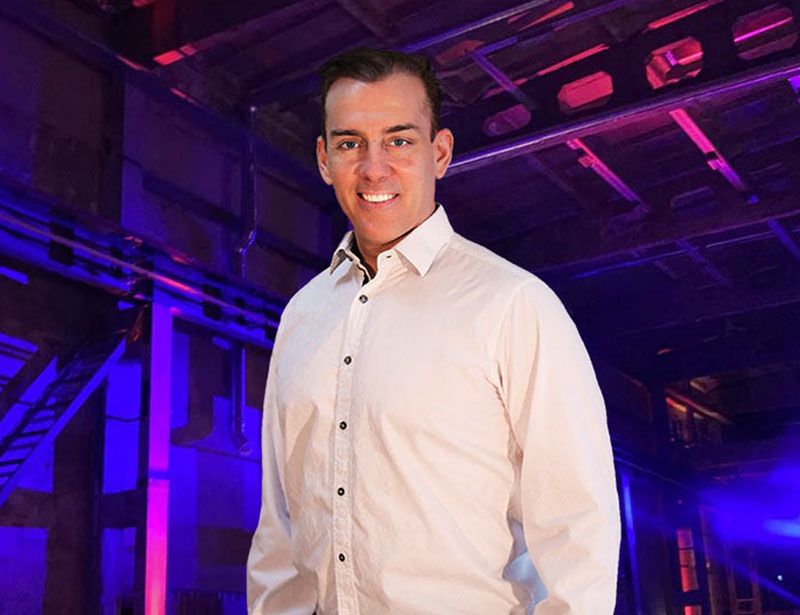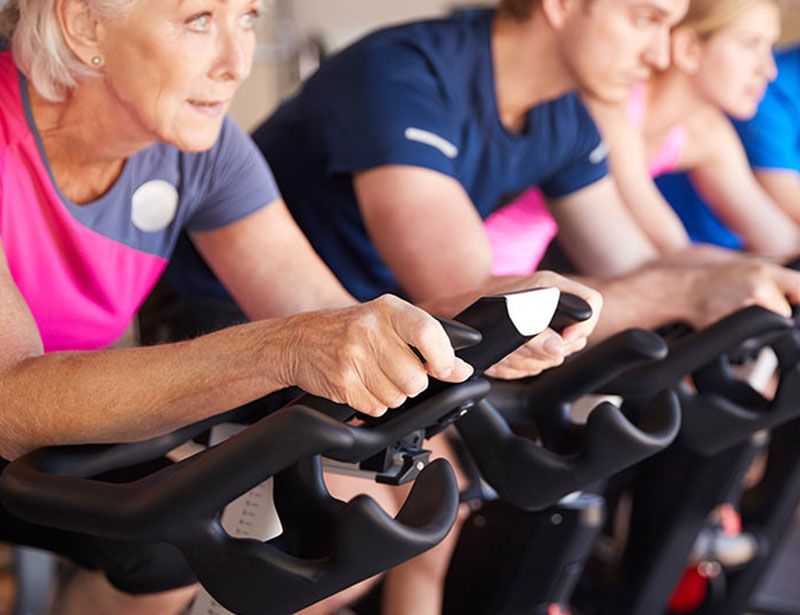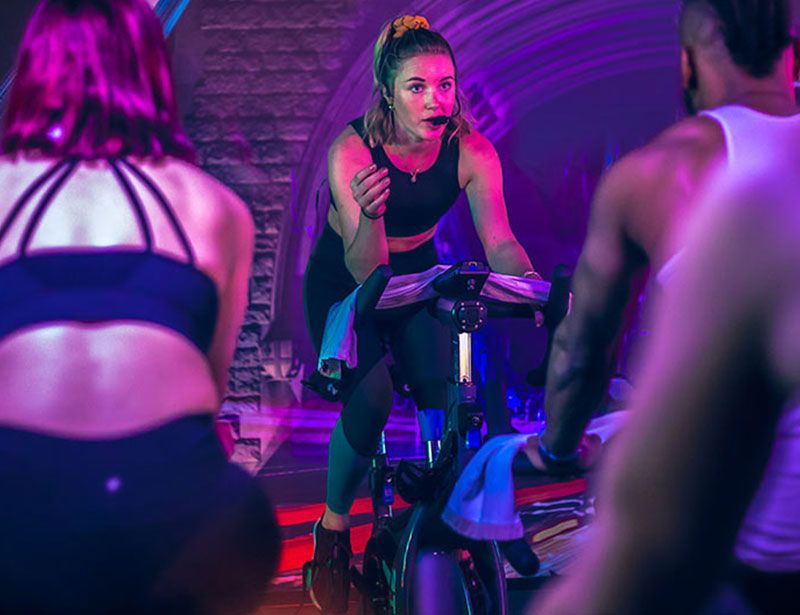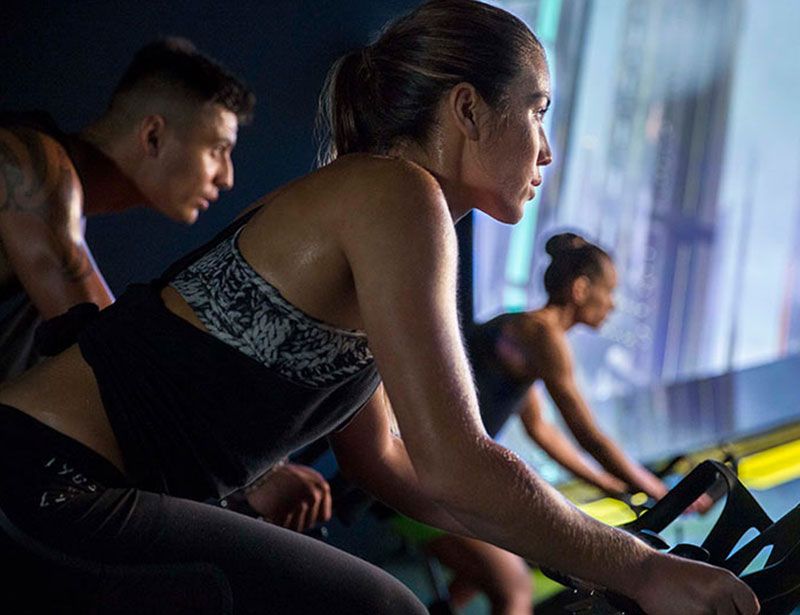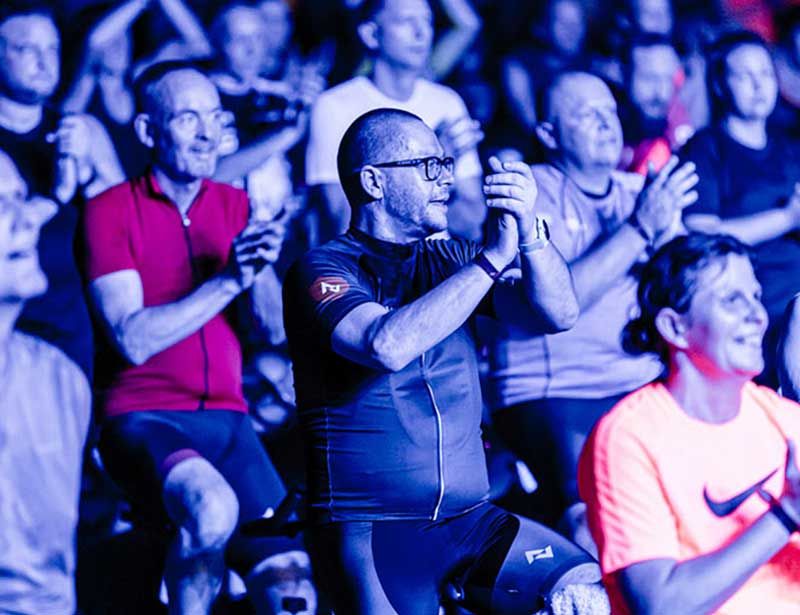Jon Davie
“In World Gym, we have the best of both worlds,” says Jon Davie who in 2006, along with his business partner Mike Nysten, acquired the Australian master franchise rights for the
US-based brand. “World Gym has a strong, global brand and a great brand story – that’s something we were very much looking for – but we were also given the autonomy to take that story, shape it for the Australian market and create a model that works here.”
He continues: “The World Gym story is a really nice one. It was founded by Joe Gold, who had previously created the male-dominated, body-building mecca that is Gold’s Gym. Having stepped away from that, he wanted to create something that was accessible to everyone. The result was World Gym.
“We liked that story and wanted to evolve it for the Australian market. We’ve kept the ‘Seriously fun fitness’ strapline, which is all about offering seriously good fitness opportunities that deliver results, all with a great sense of community and camaraderie. However, we’ve been able to design our own clubs and drive our own positioning.
“We’re keen to be family-friendly and to attract women. We build all our gyms to be non-intimidating for these audiences, and in our newest club our membership is 51 per cent female. Our marketing reflects this. Our view: the quality of our gyms will mean we attract the serious exercisers anyway, without skewing our marketing towards them.
“Because we do offer the best of the best at our gyms: the best equipment, a great
environment, excellent programming, group exercise timetables that typically offer 50–60 live classes a week plus virtual, studios that can each rival any equivalent boutique offering locally. With us, you get the best of everything you need in one place – everything you could want for your fitness regime – and all for around A$20 a week. Not only that, but we offer plenty of crèche and childcare facilities too, so your children can be looked after while you train, and wonderful social café spaces to enjoy with friends afterwards.”
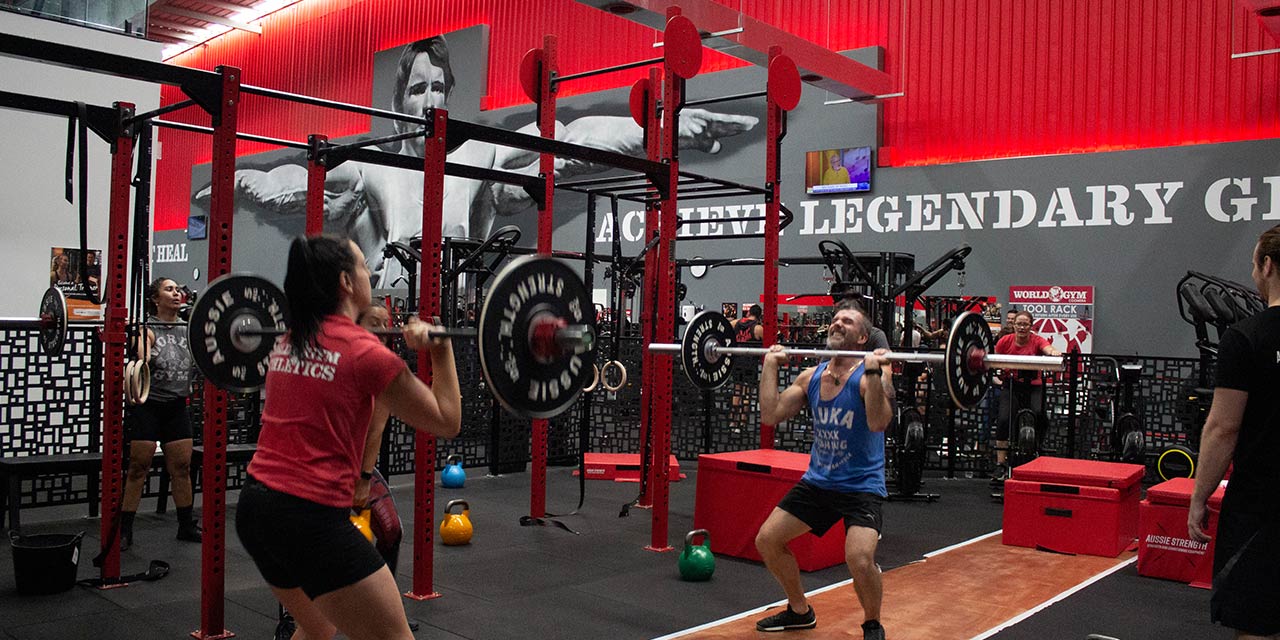
our goal is to create an environment where everyone can find their thing and enjoy their hour of fitness.
Best in class
Davie adds: “We didn’t want to start going down the route some operators have done, whereby they’ve narrowed their offerings to appeal to very specific audiences. We offer everything from traditional group exercise to heavy lifting, because our goal is to create an environment where everyone can find their thing – where anyone can come in and enjoy their hour of fitness, whatever their chosen form of fitness might be.
“As a result, although our core target market is 17- to 38-year-olds, we also have younger members coming in – some of our gyms are located in schools, and teachers tell us the kids enjoy their PE lessons more when they take place in the gym environment – right up to those aged 80 and above who are looking to improve quality of life and stay mobile. We have women doing Olympic lifting; there’s roughly a 50/50 male/female split on our World Gym Athletics Foundation Levels 1–3, which teach technique to allow you to lift properly and avoid injury. We have men doing yoga to improve their flexibility; we do a lot of social media around ‘athletic yoga’, the importance of stretching for weight lifting and so on.
“But as I say, although ours is a big box model with all these different facets to the offering, the crucial difference in our gyms is that each and every aspect is designed to be the best in the market. We never do anything half-heartedly. Our functional CrossFit-style areas have bespoke World Gym Athletic programming and, we believe, rival the likes of Barry’s Bootcamp and F45; many of our yoga studios are kitted out to offer hot yoga; and our cycling studios draw on what we’ve seen during numerous visits to boutique studios in the States.”
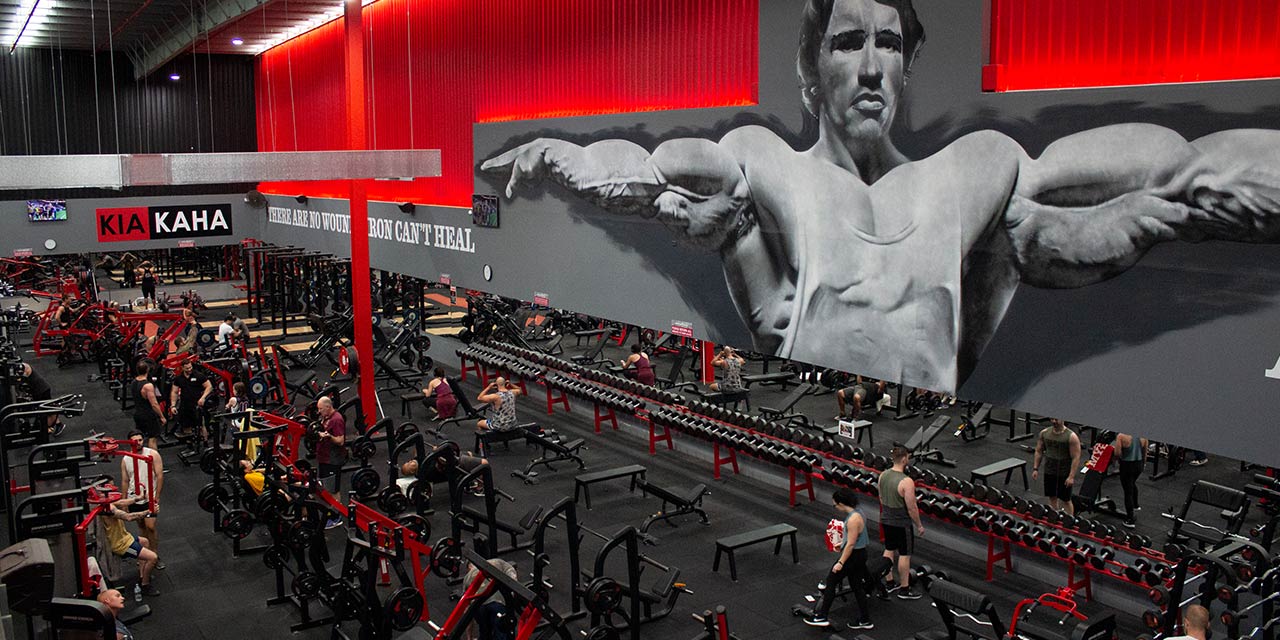
Cycling is thriving
He continues: “In our Burleigh club, for example, the cycling studio is designed like an auditorium. We have a curved room with three tiers of Body Bikes, a sloped roof, a raised pedestal for the instructor. We put a lot of detail into the mood lighting, the textures and design, the sound. We’re fanatical about this – about ensuring instructors don’t have to scream to make themselves heard and that everything blends well with the music.
“But we’re always looking to improve every experience in our clubs, and I can quite see how the studios in the clubs we open next year will be even better, including large screens at the front to run virtual classes. We find virtual to be a great addition across the board of group exercise, but with indoor cycling specifically it adds a new, immersive dimension to the experience.
“So, we’ll push our cycling studios to the next level, and the next, as standards and expectations continue to rise across the sector. We’ll develop more programming and styles of class to complement the classes we already have – RPM and SPRINT, freestyle, DJ nights and marathons – and we’ll add more virtual classes. We’ll find new ways to create a great atmosphere. We’ll build on the sense of club-in-club, potentially creating dedicated areas for cycling-only lockers that will be ready with people’s cleats, towels and water when they arrive.
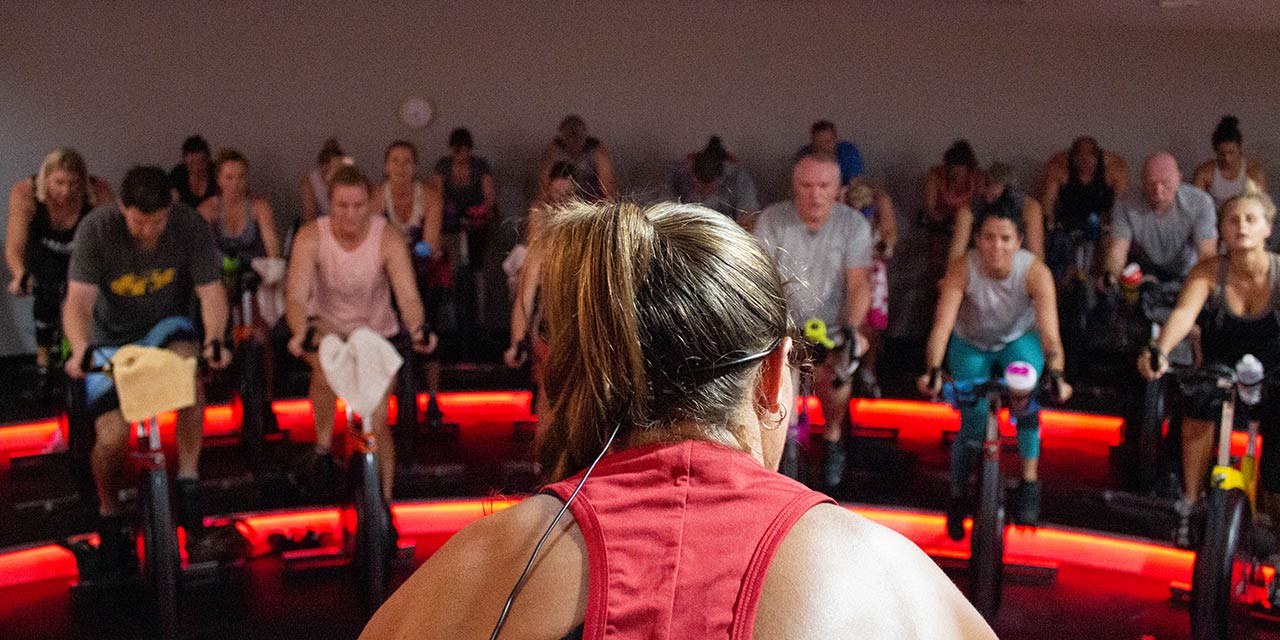
a while ago people were saying indoor cycling would die out, but if anything, it’s getting more important.
“Across all our clubs, cycling is already our most popular class: we typically offer 10–12 live classes a week and we have some members who come to us just for this. We invite feedback through social media that then shapes our timetables: what do you want more of and when do you want it – what day and what time? That often leads to more cycling, or scheduling cycling to be followed immediately afterwards by yoga.
“You know, a while ago people were saying indoor cycling would die out, but our experience is that, if anything, it’s getting more important. We just need to keep evolving to meet consumer demands. Honestly, if I only had space in a club to build one studio – general group exercise or cycling – I’d opt for cycling.”
Big box vs boutique
So, with rumours that SoulCycle is eyeing up Australia after a successful entry into the UK, what does Davie think of the pending threat from the boutiques?
Interestingly, he views the situation not as ‘boutiques versus big box’, but as ‘boutiques + low-cost versus big box’ – and for the Australian market at least, he remains confident in the World Gym model. “Rents and staff costs are so high in Australia that it’s hard to make a real success of the low-cost model,” he explains. “Neither is there the density of population, outside of areas like the Sydney CBD, that boutiques generally need to succeed. So, where in the US people are paying US$10 a month for their gym and US$25+ per class at a boutique on top of this, I don’t think this will happen as easily in Australia.
“Our view is therefore that, provided we can create experiences in our clubs that rival the boutiques, we will likely retain our members.”
But while Davie may not see boutiques as a model suited for roll-out across Australia, there is another model he does see as a strong contender, and that’s the satellite club – the smaller footprint model designed to sit between big box clubs.
“We’re just in the process of taking our World Gym Athletic brand and creating a spin-off satellite model,” he explains. “We’ve already been creating separate areas for this functional training offering within our clubs, to create a club-in-club feel, but our first fully standalone World Gym Athletic studio will open on the Gold Coast later this year. It will be a 400sq m site offering the best functional classes you can do, but for A$30 a week you will also be able to access the nearby World Gym clubs. That’s great value for the members.
Our first fully standalone world gym athletic studio will open on the gold coast later this year.
“It’s an interesting model for potential franchisees too, as it’s obviously a lower cost of entry: lower rent and all you really need is functional equipment – free weights and so on. Plus we’ve spent a lot of time creating really great programming. I can envisage this appealing to personal trainers who want to take the next step and own their own training space. We hope to open four or five of these studios over the next 12–18 months.”
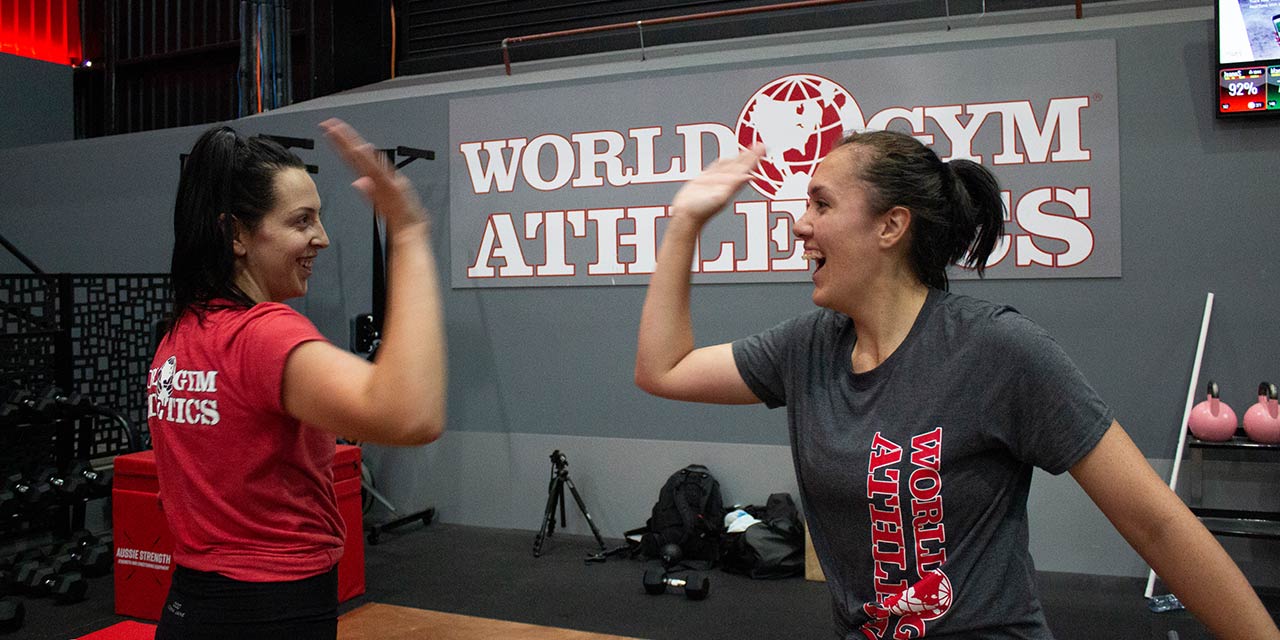
Shared success
Meanwhile, plans are to open between seven and 10 World Gyms a year over the next few years – and Davie admits he is “still pinching” himself at the idea they will soon reach 50 sites.
“Our original plan was simply to be gym owners ourselves, with a club in Sydney for Mike and a club on the Gold Coast for me,” he explains. “It was only when Joe Gold suggested we take the franchise that we even considered that option, and in the first five years we only opened three clubs. But it soon sped up as people began to recognise the brand and we got more and more interest from developers, real estate firms and potential franchisees.
“We’re now opening between five and seven clubs a year, have reached 30 clubs in total and will be opening a further eight by April 2020 – and that’s without even really touching on the big markets of Melbourne and Sydney, where we currently have only one and three clubs respectively. Those cities will be our next focus.
“But as we grow, we will stick by our pledge not to over-develop: we don’t want any of our clubs to cannibalise each other. So, for example, in Queensland, which has a population of around 3.4 million people, we now have 14 clubs and I’d say we’re done there. We don’t ever want to have a club that fails. “Neither do we push every growth opportunity: for every franchisee we take on, there are probably 20 or 30 we don’t. We take our time finding great sites and we always offer them to existing franchisees first. More and more of our franchisees are now opening second and third clubs, and that’s very rewarding for us: their willingness to re-invest in World Gym is proof the model works.
“In the end, Mike and I are first and foremost gym owners – I now have three World Gyms of my own, and between all the company directors we own nine – and we always say that we won’t let anyone open a club unless we would open it ourselves. We want every single one of our franchisees to be successful. That, for us, is the measure of our own success.”
Esben Dalgaard Andersen
Esben, let’s start by you telling us a bit
about yourself…
I was educated at Odense theatre school in Denmark, graduating in 2008, and have worked as an actor – across TV, theatre and film – ever since.
When you start out as an actor you need a bit of luck to come your way, and fortunately that’s what happened for me: I got a good gig on a TV series in Denmark, a police drama called The Protectors, with the first series airing in 2009. Since then, I’ve regularly appeared on television as well as on-stage as part of the Royal Danish Theatre.
I won’t try and mention everything I’ve been in, but one TV series that received international acclaim was 1864, which was a big budget production centred around the Danish war of that year. I played a miller, and he was one of those stereotypical millers: huge and strong but also a bit overweight, eating too much of his home-made white bread.
When I first auditioned for the role, I was told I was far too small and they went away to try and find someone bigger. But they kept coming back to me and in the end offered me the role provided I gained 32kg. So, I did – I got up to 120kg – and then filming was delayed by four months, so I had to keep that weight on!
Other roles people might have seen me in include The Stranger, which was a really interesting, boundary-pushing film that won the main prize at DOC NYC, New York’s documentary festival. And then The Good Traitor will be out next year – we’re shooting that film at the moment and it’s due for international release.
Then there’s one that readers in Denmark will be very familiar with: our Christmas calendar TV series. For anyone not in Denmark, these are family-friendly stories that are screened on prime-time TV every year – half an hour every day from 1–24 December – and that pretty much the whole country tunes in to watch. I was in Tinka three years ago, and by the time this article is published will have appeared in Tinka 2, in which I play a big elf who wants to become king of the elf kingdom. And yes, when I say ‘big elf’, I mean I had to gain weight again – I needed to be 118kg for that role.
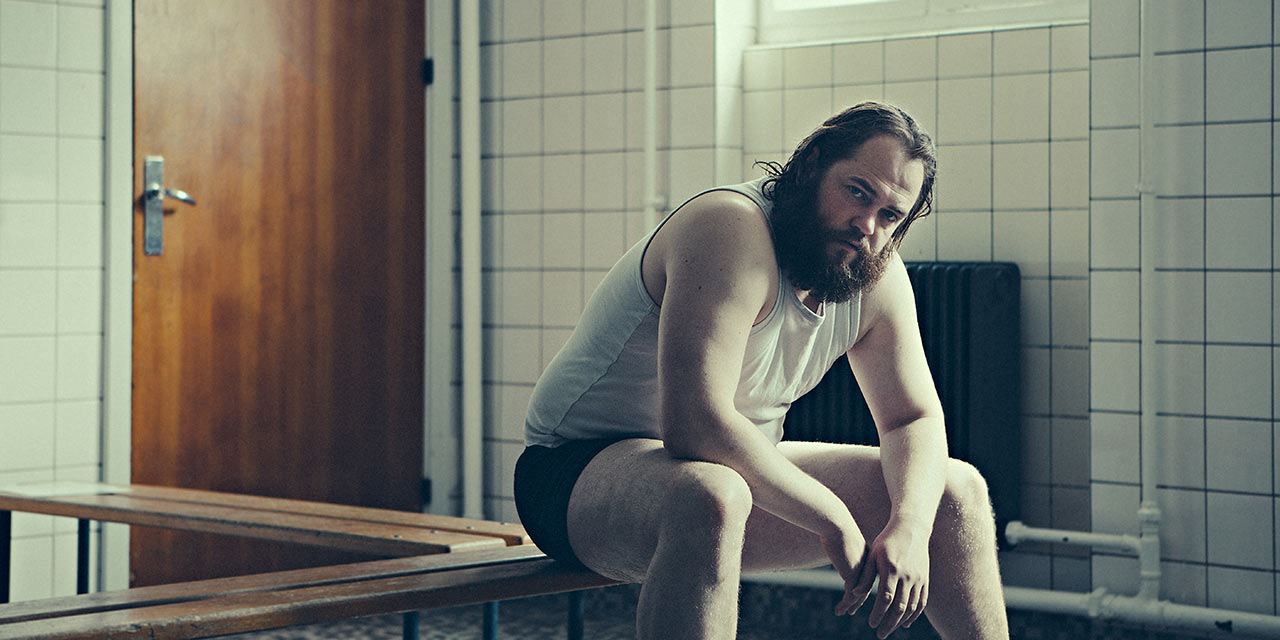
How often do you have to gain and lose weight?
I’ve had to go up and down quite a lot. For example, for 1864 I had to gain weight, then immediately afterwards I had to lose 25kg for another role. And recently I had to gain weight for Tinker 2 and, again, immediately lose it to film a TV series, Hand in Hand.
So far, it’s been a case of gaining weight and then coming back down to somewhere around my natural weight, which means fluctuating between about 85-90kg and 120kg.
I’ve never had to be super-skinny, although it might be interesting to try that some time; I find it very interesting to explore different weights, as it allows me to explore my range and versatility as an actor. Changing shape allows you to take on new roles; people actually approach you differently, perceive your personality to be different, depending on your size.
It probably isn’t healthy to keep shifting weight up and down so dramatically – I don’t suppose a doctor would approve, as obviously I’m putting fat on around my organs too – but as an actor, I think changing shape is a good thing to do.
What’s your weight gain formula?
Weight gain is the easy part – it’s just about over-eating. Lots of chocolate, white bread and butter, sauce on everything, potatoes every night. I’ll even set my alarm for 2.00am, get up and eat some bread and drink a hot chocolate, then go back to bed again!
I do also try and gain muscle though: my characters, even when I’ve been bigger, have tended to be strong and muscular as well as overweight. When I’m preparing for these roles, I do lots of weight training and very little cardio.
And what’s your secret when it comes to weight loss?
The challenge really is how quickly I have to do it, as I often don’t have long between roles. So, my secret – and please note, I wouldn’t recommend this for everyone, it just works for me – is that I simply stop eating.
Normally, when people say they’re fasting, they’re talking about the 5-2 diet. My approach is different: I don’t eat at all for 72 hours,
just drinking water and coffee. And then for the rest of the week, I eat very little – some meat, vegetables, Skyr yoghurt… Then I repeat that the following week, and so on until I get to my goal weight.
I also train, of course. Ideally I’d be weight training, building muscle to drive weight loss, but sadly I rarely have the time for that. So it tends to be about cardio: running and Indoor cycling.
if it were down to willpower, i would find weight loss as hard as everyone else
I can lose at least 2kg a week by doing this, and I manage to do it without getting moody or losing concentration. I can still work and train. I don’t know how, but it just works for me.
What I would say, though, is that if it were down to willpower I would find weight loss as hard as everyone else. It’s only because I have that cross
in my calendar – that date by which I have to be ready, by which I have to deliver the right look – that I can do it. That cross means I’ll go through hell to do it!
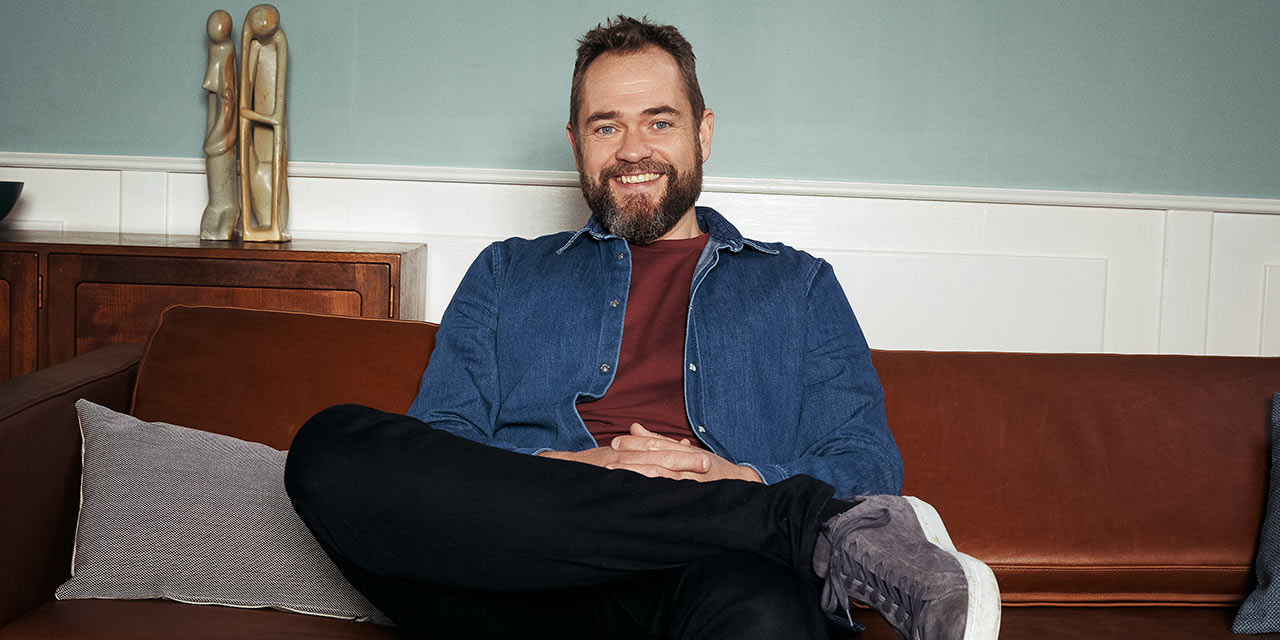
Is indoor cycling something you do just for weight loss?
Not at all. I first discovered Indoor cycling maybe 15 or 20 years ago when it first really started making waves in Denmark. My friend and I went to try it out and we managed to get ourselves into the high-performance class. We’re quite competitive, so we really pushed ourselves and when I got home I collapsed!
I’m hooked on indoor cycling. if the instructor is at the front shouting at me to push myself harder, that’s perfect.
That might sound like a cautionary tale about Indoor cycling, but it isn’t at all. It was my own stupidity. I was taken to hospital for an ECG and there was nothing wrong with me, other than I’d pushed myself so hard that my body had produced too much adrenaline to be able to then cope with! Basically, I over-trained, and I’ve been teased about it ever since. But that’s me, that’s my psyche when I work out. I like to be really pushed and to beast myself.
I found myself totally hooked on Indoor cycling and have done it ever since. I know not everyone likes this style of coaching, but for me, if the instructor is at the front shouting at me to push myself harder, that’s perfect. I like to really sweat. I also like going for a run, but I’ll only go in the heat of the day when I know I’ll sweat straight away.
I have an indoor cycling bike at home, too, and have had for several years. I prefer live classes, but I can’t always make it. Having my own bike means I can do a class whenever I like – I just find one on YouTube, so there’s still someone shouting at me, and put my headphones in. I’ll then feel good for the rest of the day.
So that’s my routine really: cycling, running and weights. I did take part in Dancing with the Stars last year and came third, but I aconfess I haven’t carried on with that!
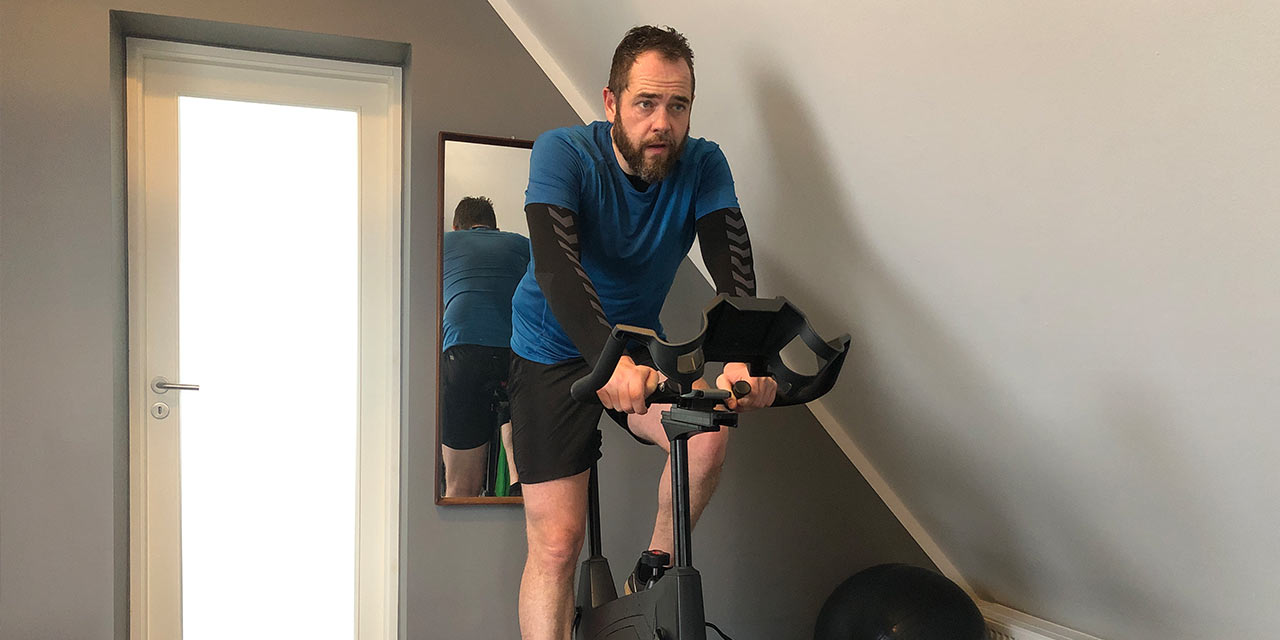
Have you passed your exercise enthusiasm on to your children?
Healthy living is an important topic in our household. My eldest daughter is 14 and she’s really into training. She and I go running together – she’s faster than me, I’m better at endurance, but we find a way to make it work together. And my wife runs every day.
But my little one… we have to be quite careful with her. She doesn’t exercise as much, but it’s the eating we’re really focused on with her at the moment. She’s only seven, but she’s already talking about wanting to go on a diet. It’s very difficult, because of course she sees her dad dieting, and pretty dramatically at that. There’s no hiding the fact that I fast for three days straight, because I’ll be at the table with them but not eating. But we don’t want her to get the wrong ideas about food. We want her to know it’s OK to eat. We’re having to find the right way to talk about food and exercise, about healthy eating.
This is a side-effect of my regime – the weird stuff I have to do – that we hadn’t thought about before. I don’t want to be a negative role model for my children. Women in particular have enough pressure as it is, with the skinny images they think they have to match up to if they want to be the perfect woman.
It’s really hard when my appearance, my weight, is so important, but I want my girls to grow up knowing that happiness comes from within.
JJ Sweeney
From elite trainer to co-founder of Celebrity Fitness to founder of new health club brand Paradigm, JJ Sweeney tells Kate Cracknell about his journey through fitness, and how his experiences have led to the creation of his perfect club
You were one of the co-founders of Celebrity Fitness in Asia. What was your journey up to that point?
I was always interested in fitness. When I was younger, back in Ireland where I grew up, I would take part in amateur cycling races at the weekend, cycling 150 or 200 miles.
After doing a diploma in sports science, I spent five years in New Zealand, training top athletes including Annelise Coberger, who won silver in the slalom in the 1992 Winter Olympics. I left New Zealand in 1994 and spent five years in Japan, managing Hilton Hotels’ health clubs across the country, followed by a stint in Taiwan working with California Fitness.
That’s where I met John Franklin, who along with Mike Anderson and my wife Miho were the three other co-founders of Celebrity Fitness, which we launched in Jakarta, Indonesia, in 2003.
What was the model at Celebrity Fitness?
When we set out, there were no other health club brands in the market. We really were
starting from zero. But we latched on to what people wanted – which in Asia was energy and entertainment – and we came up with a concept people had never seen before. It was Hard Rock Café meets Grand Hyatt Hotels meets Las Vegas. We wanted to take the best of all of those places, those distinct sectors, and put them into a fitness company. We wanted to create a place that felt like going on vacation for all those members who had spent the day in an office. That was the dream.
We had very cool, design-led clubs. We did lots of events and we had incredible group exercise. Our cycling studio, for example, started off as a darkened room, but it also had a fluorescent dome in the ceiling and lights in the floor, and as these lit up – combined with the great instructor and music – there was such an energy in the room. I used to love instructing myself, seeing people’s reactions as the class went on.
What were the key milestones for the brand?
Having launched the first club in 2003, we opened 16 clubs in the space of four years. At the end of 2007, we were acquired by Kuala Lumpur-based Navas Capital, who were very keen to see the brand expand.
We subsequently moved into India and Turkey, but things didn’t go our way there, so ultimately those clubs were sold off. We regrouped and instead focused our growth on the markets we were already in: Indonesia, where we grew to around 37 clubs in 12 cities; and Malaysia, predominantly Kuala Lumpur, where we got up to about 22 clubs. We also opened five clubs in Singapore.
But then things changed again in June 2017, when Celebrity Fitness merged with Fitness First Asia. The Singapore clubs were rebranded as Fitness First and a few clubs were closed in Indonesia. I only stayed with the business for six months following the merger.
What were your key learnings from your time at Celebrity Fitness?
The brand started out being really cool, really design-led, but as it grew to multiple sites in multiple countries that character was toned down. We had new people in the senior management team – that’s inevitable when you expand beyond a certain point – and in the process, the dream we had had as co-founders became somewhat diluted. There seemed to be less creativity. It felt like a number of different concepts and visions were being pushed together and I didn’t feel it worked.
So, while I wouldn’t change a thing about what we did as co-founders, my key learning would definitely be not to expand as fast as we did. It would be to spend more time building really strong foundations, training and developing staff and not pushing them into management roles before they were ready.
As new clubs opnened, they didn’t ‘copy and paste’ as i woud have liked. that impacts the member experience.
I recognise that, if we hadn’t grown fast, another brand would have come in and seized that opportunity, but it did feel a bit out of control at times. As new clubs opened, they didn’t ‘copy and paste’ in the way I would have liked them to, and of course that impacts the member experience.
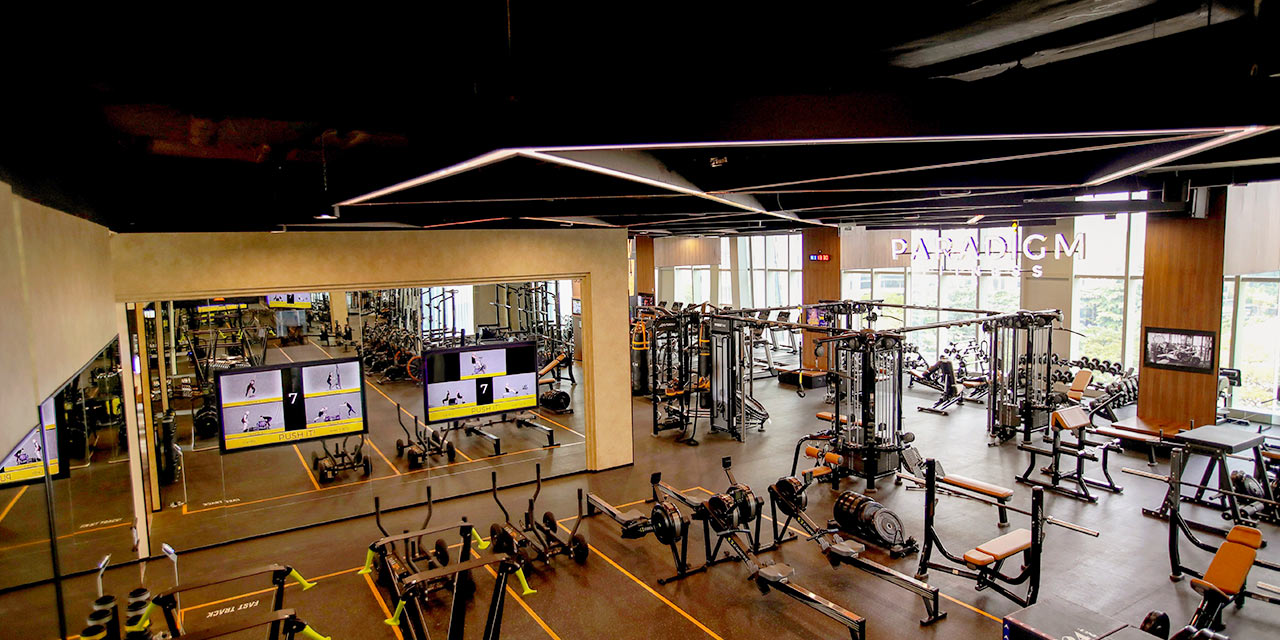
You’ve now founded a new health club brand: Paradigm. Please tell us more.
Paradigm opened in Jakarta in February 2019 and what we’ve created is a genuinely new and unique concept. I honestly believe, if it were to open in New York, London, Tokyo, it would be THE place to go. I spent a year and a half planning it, unable to sleep for thinking through all the detail. I’ve done everything exactly as I wanted to.
Design-wise, when you walk in, the reception and lounge are like a six-star hotel. The changing rooms are stunning, with wooden floors and marbled bathrooms. The gym is raw and functional – a powerful contrast to the reception area. And then there are the studios, which have a real wow factor: we have a beautiful cycling studio; a 300sq m group exercise studio with space for 120 people in a dance class; and an intimate mind-body studio with space for maximum of 16 people. And then the whole club is surrounded by floor to ceiling windows, so you almost feel as though you’re outdoors – the views are incredible.
We’ve also chosen to be in the first LEED Platinum building in Indonesia, where everything has to be energy-saving and environment-friendly, to the point of them checking any materials we wanted to use in the build.
paradigm is all about mind, body and spirit. a lot of operators talk about this, but few actually do it. we do.
Equally important at Paradigm is our holistic ethos: we’re all about mind, body and spirit. A lot of operators talk about this, but I believe few actually do it. We do.
One great example is our Soundbath class, which we run every day at lunchtime to help people de-stress and recharge. We’re located in Jakarta’s CBD (central business district), surrounded by offices, so there’s huge demand for this service. You don’t even have to change into gym kit. You just go into the mind-body studio, lay down on comfortable blankets, put on an eye pillow and we play special healing music that creates vibrations through your body. You start to see colours: you’ll see yellow if you’re in a creative state, blue if you’re in a dreamlike state… It’s a wonderful class.
We also run other mind-body classes such as yoga, mobility, barefoot, meditation, SMR (self-myofascial release). We’re finding a lot of people are joining us just for these, and even those who are into their weights and high-intensity work are loving the scope we offer for active recovery too. The way I explain it, exercise is important, but ‘inner-cise’ is just as important.
when i left celebrity fitness, people wanted to follow me. i hand-picked those i considered to be true superstars.
We have around 90 group classes a week and we encourage everyone to take part; around 70 per cent of our members do. It helps, of course, that we have exceptional instructors. When I left Celebrity Fitness, a lot of people wanted to follow me, but you can’t take everyone. I hand-picked the best of the best – the people I considered to be true superstars.
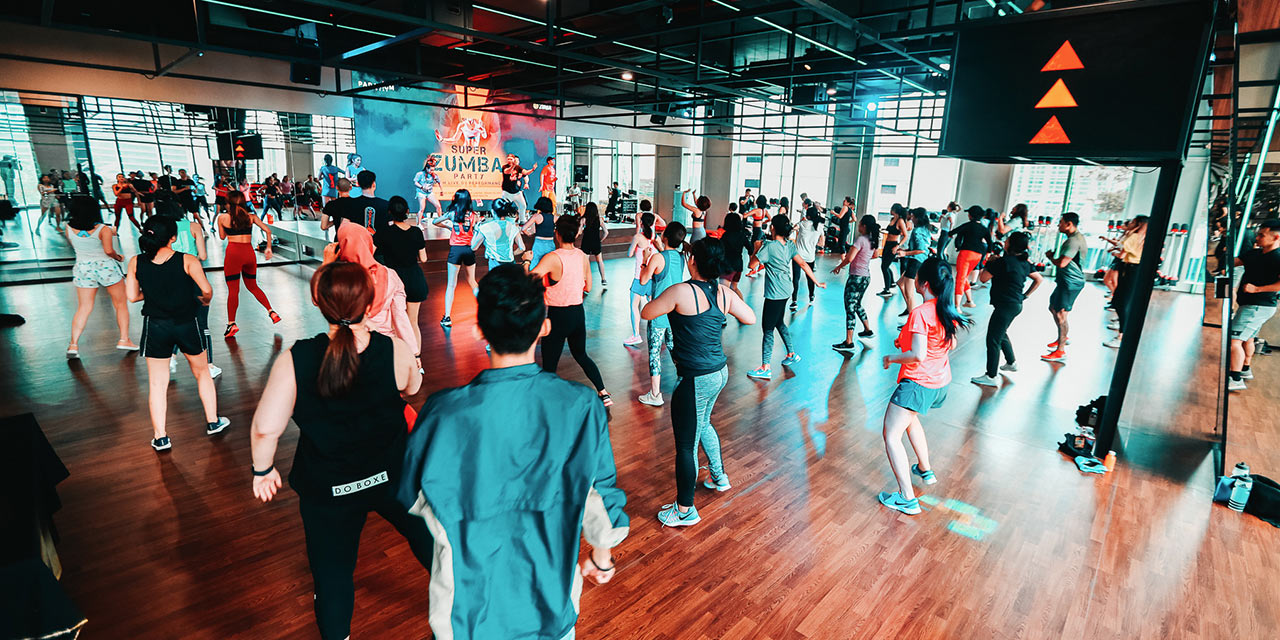
Tell us a bit more about the fitness spaces at Paradigm.
The gym floor is split into five zones. The first is Fast Track, which does host some live classes as well as DJ nights two or three times a week, but its primary offering is virtual classes, which you can do on the hour, every hour. We create this virtual content ourselves.
The rest of the gym space is very raw, with no traditional strength equipment – it’s all about standing up, about movement. There’s a Free Weights zone, a Cardio zone, a Kettlebell zone and a Calisthenics zone. This Calisthenics zone features the sort of equipment you’d often find on a beach, with bars and Olympic rings and so on, but we decided to bring it indoors. We have 7m-high ceilings, so we have the space to do aerial stuff, and in fact we’ve combined this with a climbing wall and peg boards that go up 5 metres.
We also worked with Life Fitness to create the first four-pillar cable machine in the world, which is nicknamed The Beast and which sits alongside equipment like power racks, benches, free weights, the Nautilus glute drive… and lots of open space.
Sound is really important to us. Throughout the whole gym floor space, we have 16 sub-woofers. It means you don’t just hear the music – you feel it. It feels like the music is really pumping, but without having to crank up the volume to a point where you can’t hear each other speak.
Then we have our studios. The largest one has a 6m x 3.5m LED screen at the front, on which we project imagery and video to enhance each class and create an immersive environment. Our cycle studio is a really cool space too, with fantastic lighting, a 3m x 3.5m LED screen showing MyRide video footage from around the world, and an exceptional sound system – it has two sub-woofers of its own, just in the studio, so you feel the music but can still hear the instructor very clearly.
The way we describe it: as a 2,000sq m site, Paradigm is a big-box boutique.
Tell us a bit more about your cycling classes.
I’m not a huge fan of all these ‘party on a bike’ classes. Yes, it’s fun and the music might inspire you, but my view is that you get better results if you’re really focused on what you’re doing, if you’re really aware of your body.
I therefore like to teach indoor cycling as if it were road cycling. I like to teach people how to climb and race in the right way, how to engage their whole body: legs, core, upper body. I like to focus on the movement, on technique. Because if you do all this, you’ll burn more calories and get better results.
That’s our approach at Paradigm. We use ICG’s Coach by Colour system for all our classes, where you train in colour-coded zones: we currently offer a 50-minute Colours class and a 30-minute Performance class, and I’m working on two more formats which we’ll launch soon.
Performance is about 25 per cent harder than Colours – you’ll cycle about 12km in the 30 minutes, compared to about 17km in 50 minutes in Colours. In each class, the structure is set – the order of the coloured zones you go through, culminating in a team competition at the end – but the instructor is free to do his or her own choreography. The colour zones are all we dictate.
Interestingly, where at Celebrity Fitness the cycling was all about motivation and
excitement – the instructors really had to be performers – at Paradigm the member
mindset is proving to be different. The members are very focused and are more interested in the data, in their results, in the instructor getting them through a good workout and helping them stay focused. It’s perhaps down to our location in the CBD, which means we have a lot of competitive high-fliers among our members – we have over 30 CEOs, for example – but they’re more interested in getting results than in being entertained.
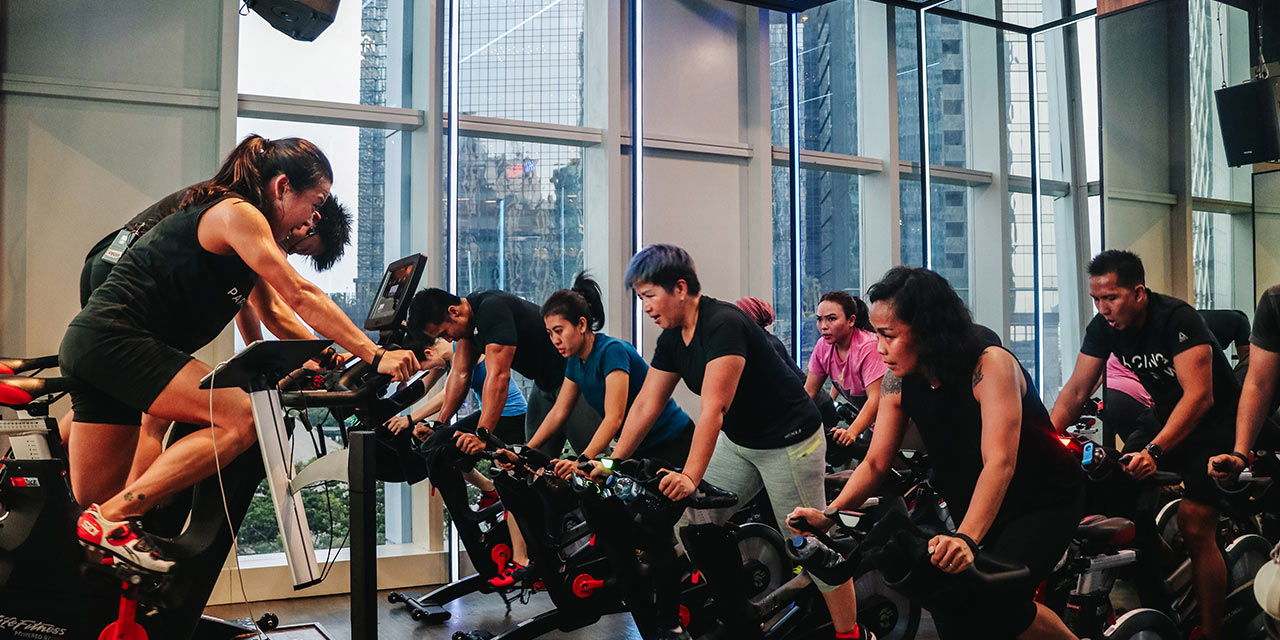
You refer to Paradigm as a luxury fashion brand. What do you mean by this?
When people get into fitness, over time their body changes shape – but the way they feel also changes. The way they act, their attitude, their self-confidence, the clothes they choose… their whole body language changes. That’s why I see fitness as fashion. We help people fall in love not only with fitness, but also with themselves and with fashion.
By offering all of that within a unique, premium space, we’re also finding others are seeing us as a fashion brand. We’re collaborating not only by the usual sportswear brands, but with the likes of Calvin Klein, Estée Lauder, Guess. For example, Calvin Klein recently organised an event for 300 people at Paradigm, as well as a pop-up store in front of the club. People are seeing us as a fashion brand and we’ve gone viral.
How has Paradigm performed so far, and what are your expansion plans?
It’s going very well so far. We’re currently at 900 members [as at October 2019] and I’d like to get to 1,600, but break-even would be around 1,100. Membership costs around US$80 a month, up to US$350 to include 10 PT sessions. That makes our price point twice as much as Celebrity Fitness, for example, so we don’t need to have thousands of members.
Going forward, I only want to open three or four Paradigms in total, all in Jakarta. I want to keep it exclusive, to create a tight-knit community, to keep standards really high. I want it to be a place where members spend time, and where I can take the time to be on the gym floor engaging with them, teaching them new techniques to help them get results.
I’m therefore not in a hurry to open our second club. The space has to be perfect. We want the high ceilings and the windows. I’ve looked at a few places but they weren’t right – but interestingly, I’m now finding myself being approached by developers who are actively asking me what they want so they can build it for me.
What we will definitely do in 2020 is launch the Indonesian Fitness Academy. I’m concerned by all the influencers on social media who are persuading people to follow them and their advice, but without it being based on any real knowledge or certification – nothing more than their own personal experience. Everyone’s needs are different; to get the best results, you need expert advice and a personalised training approach.
influencers on social media are persuading people to follow them, but without any real knowledge or certification.
We already spend a lot of time educating both members and our staff to address the
misconceptions they’ve picked up from social media, but I now want to do even more to ensure instructors have an in-depth understanding of the human body, and of how to train different types of people.
It is only by doing this – by helping members get results – that we can really get them to fall in love with fitness.
It’s never too late
Exercise is good for you – that much is all but undisputed. But could it be that it actually gets better for you as you get older?
This was the fascinating question at the heart of a study – published in the journal Cell
Metabolism and reported in The New York Times – which looked at the impact different forms of exercise can have on a person’s body, and at different stages of their life.
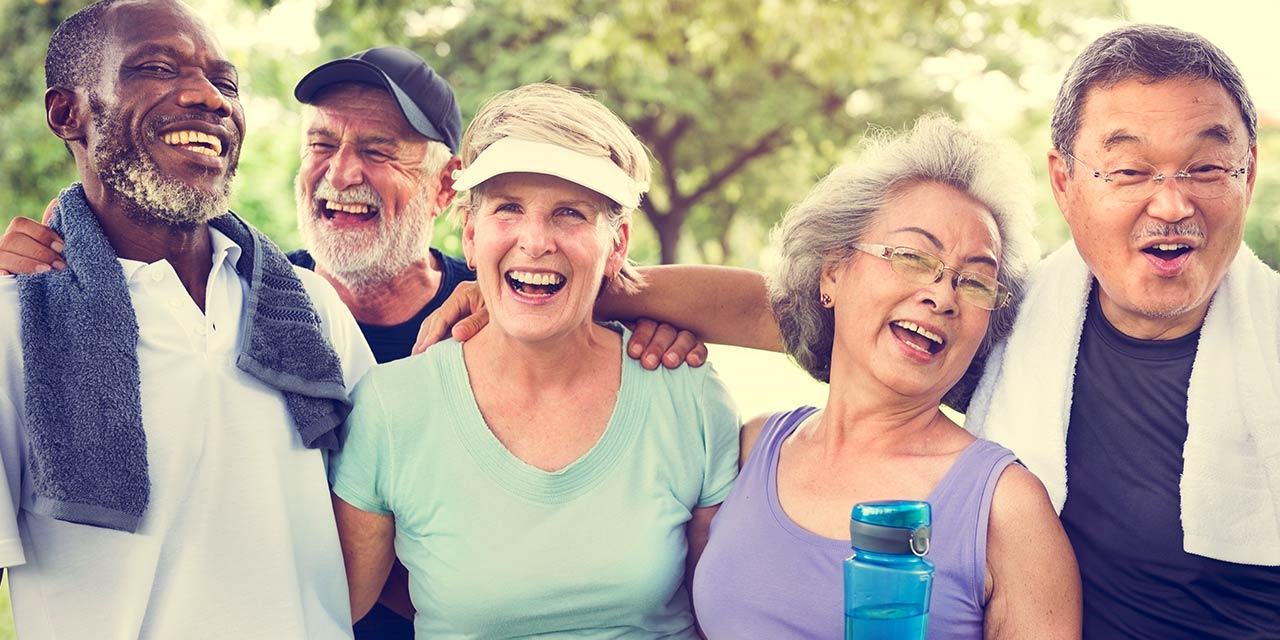
the activated genes influence the ability of mitochondria to produce energy for muscle cells.
Old versus young
Researchers at the Mayo Clinic in the United States conducted an experiment involving 72 healthy but sedentary men and women, all of whom fell into one of two age groups: 30 years or younger; or older than 64. All participants were randomly assigned to a particular exercise routine.
- Group 1 undertook vigorous weight training several times a week.
- Group 2 took part in 30 minutes’ moderate intensity indoor cycling a few times a week, interspersed with light strength training on other days.
- group 3 took part in interval training on indoor cycles three times a week (four minutes flat-out pedalling followed by three minutes’ rest, repeated a further three times).
- Group 4 was the control group, doing no exercise at all.
Tests were conducted before the experiment began and again after 12 weeks, measuring aerobic fitness and blood sugar levels, as well as gene activity and mitochondrial health in participants’ muscle cells (mitochondria being the powerhouses within our cells that, among other things, turn the food we eat into the energy we need to function, and that typically dwindle in number and strength as we age – in turn causing our bodies to weaken).
Boosting cellular health
Many of the study’s results were unsurprising. Improvements in fitness and ability to regulate blood sugar were observed across the board. Meanwhile, group 1 experienced the greatest gains in strength and muscle mass, while group 3 saw the most marked improvements in endurance and stamina.
Things became less predictable when it came to the results of the muscle cell biopsies.
Among participants aged 30 and under:
- Group 1 – activity levels changed in 74 genes
- Group 2 – activity levels changed in 170 genes
- Group 3 – activity levels changed in 274 genes
Among participants aged over 64:
- Group 1 – activity levels changed in 33 genes
- Group 2 – activity levels changed in 19 genes
- Group 3 – activity levels changed in 400 genes
And why does this matter? The New York Times concluded: “Many of these affected genes, especially in the cells of the interval trainers, are believed to influence the ability of mitochondria to produce energy for muscle cells; the subjects who did the interval workouts showed increases in the number and health of their mitochondria – an impact that was particularly pronounced among the older cyclists.”
HIIT training on an indoor cycle could, it seems, be the best form of exercise to improve the cellular health of our muscles – and the good news for those of us getting older is that it’s never too late to benefit from this form of exercise.
I got Rhythm
It’s Friday 25 October and I’m at David Lloyd Derby – a club of which I am, in fact, a member – to take part in a pre-launch masterclass for Rhythm, one of the operator’s new signature cycling classes.
I’m looking forward to it. Of the two new classes – Rhythm and what will, come next year, be called Cyclone – Rhythm is the one I’m guessing will best suit my indoor cycling preferences. I’m expecting something SoulCycle-esque, focused on music and the feelgood factor.
I’m also looking forward to it because this isn’t the first time David Lloyd has launched a club-in-club, boutique-style concept. I’m already a huge fan of Blaze, its heart rate-based HIIT offering: think darkened room, music and lighting synced to the workout, three rows of eight stations – treadmills, weight benches, punch bags – and specially trained instructors. It’s superb and, if not wildly dissimilar from other boutique offerings out there, it’s available as part of my membership. That gets a big thumbs-up from me, and it seems from other members too: Blaze has 22,000 unique users every month across the 63 clubs currently offering it, with an astonishing 99 per cent of users ‘very happy’ with their instructor in member satisfaction surveys. Perhaps little surprise, then, that David Lloyd Clubs has recently announced plans to open standalone Blaze studios too.
So, I’m expecting good things of the new cycling classes, both of which are due for imminent launch at the Derby club; it will, in fact, be the first club in the country to launch both Rhythm and Cyclone at the same time.
Into the saddle
As I walk in to the cycling studio, it’s clear it has had a refurb and a new AV system since I was last in there: the sound is great and the new lighting, I’m told afterwards, is Stages Flight intensity lighting.
More of Stages Flight in a moment… For now, it’s all about Rhythm.
From the outset there is, as I expected, something distinctly SoulCycle-esque about the set-up, from the helpful welcome and assistance from a bubbly instructor, to the darkened room and candles on-stage, to the music already pumping out to create a party vibe.
And I have to say SJ – the former dancer turned master trainer running the class – is exceptional in her direction and motivational skills. There’s an infectious enthusiasm, a great balance between encouragement to push and encouragement to let it all go, and a flow between bike and floor-walking that felt really natural. Let’s hope the instructor auditions uncover similar superstars for Derby!
while there is a bit of choreography going on, it isn’t so much as to make me feel unable to do it.
But once the class really gets going, differences start to emerge – and they are differences I rather like. First of all, while there is a bit of choreography going on, it isn’t so much as to make me feel uncoordinated or unable to do it. There’s no watching in awe as front-row regulars do double-time tapbacks while I have to settle for pedalling to the beat. That does two things for me: firstly, I feel more motivated to keep going; and secondly, it allows me to focus more on my workout.
And this is the other big difference for me: the workout. While this is a rhythm-based class, I feel like there’s a greater emphasis on performance than I’ve found in some other ‘party on a bike’ rides. We’re talking intervals, hill climbs, pushing the resistance right up to your own personal 100 per cent at times. Annoyingly I’d left the belt part of my MYZONE at home, but others using theirs were, at the end of the class, surprised to see how much of their workout had been in the yellow or even red zones – surprised because it had still felt like fun.
So the programme gets a thumbs-up from me. If I had to be critical, there is one element I think I would remove: the hand weights track. In Rhythm, you stop pedalling for this – a good call – but in that case, does the workout even need it? For me, it was a fantastic cycling class. While I appreciate the hand weights track was there for active recovery before the last big push, I think I’d have preferred to have another great cycling track – and this from someone who’s far from a cycling purist.
But that’s just my opinion. And of course, once Rhythm has been fully launched, if I do feel I want more cycling I can always opt for a 55-minute class instead of this 45-minute one; incidentally, 30-minute formats will also be available.
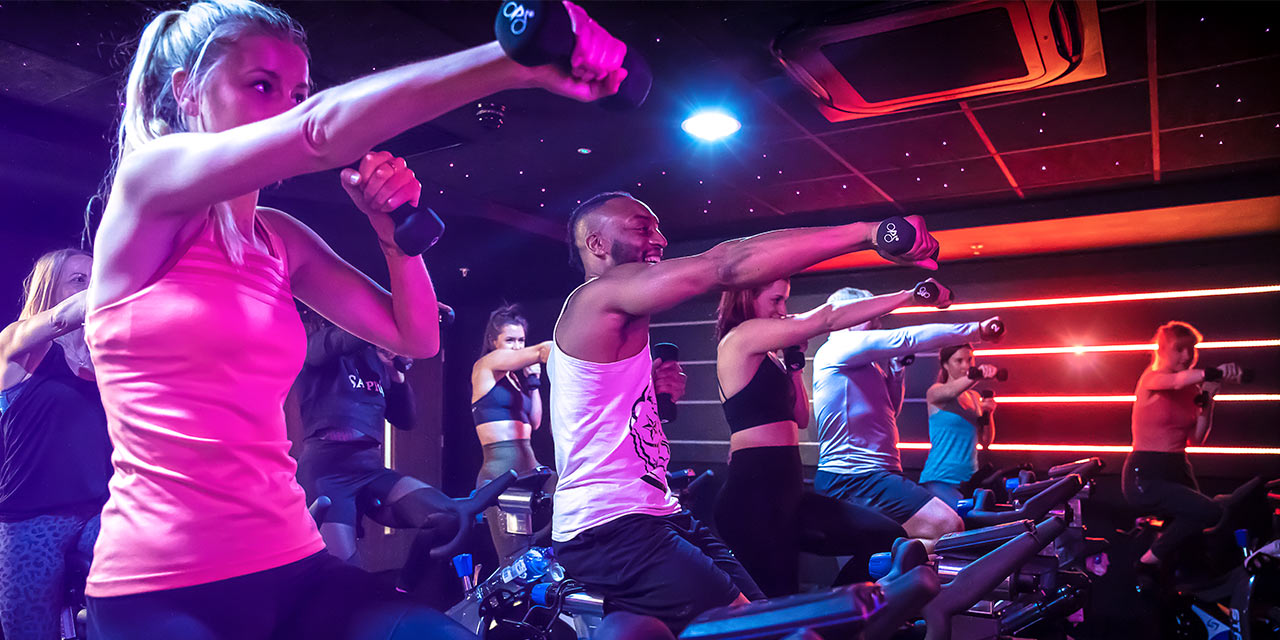 Rhythm roll-out
Rhythm roll-out
Marie Graham is David Lloyd’s product head for cycling. She explains: “We’ve created the concept, product, programming and instructor training for Rhythm, as well as the ongoing education, and it will be a David Lloyd signature product that’s available only at our clubs. By the end of 2019, Rhythm will have launched in 25 clubs in the UK and Europe, with plans to roll it out to a further 23 clubs throughout 2020.”
a cycle class can be an emotional, musical journey, but it can also be stats- and performance-based.
But what David Lloyd has sensibly done is steer away from being a one-trick pony, complementing Rhythm with a performance brand – Cyclone – under which it will be offering a range of stats-focused, power-based classes.
“The ultimate goal is to get more people into the cycle studio, and that means getting past people’s misconceptions of what a cycle class is,” says Graham. “It can be different things: it can be an emotional, musical journey, but it can also be stats- and performance-based. Our two new products reflect this.”
Neither is Cyclone a ‘one size fits all’ format, instead offering a range of options from which instructors can choose: HIIT, aerobic training, endurance training, and even advanced performance-based rides.
Importantly, as with Rhythm, these classes are designed to be inclusive and achievable, not just for elite athletes. Cyclone will allow riders to book a specific bike, so people’s FTPs can be pre-loaded onto their consoles, and that means workouts are personalised: everyone will be challenged to hit the same zones, but the wattage needed to achieve this will differ from person to person.
“Our approach ensures we can cater for all interests within cycling, hopefully growing the number of people taking part,” confirms Graham.
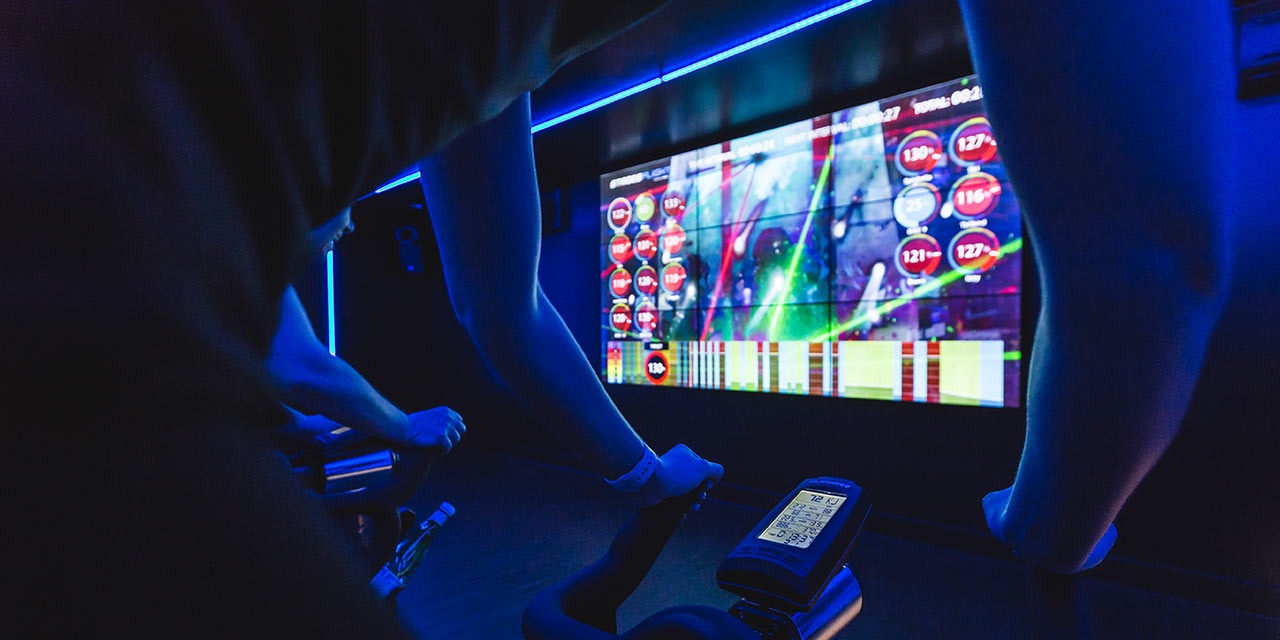 A cyclone is coming
A cyclone is coming
The story with Cyclone isn’t quite as clear-cut as Rhythm, in that the 14 clubs that have been piloting the concept actually have Stages Flight at the moment, not Cyclone. It’s only when Cyclone is launched in 2020 – to these same 14 clubs, as well as to a further 36 by the end of the year – that the programme will become ‘Cyclone powered by Stages Flight’.
Graham explains: “Stages Flight is available globally; we currently offer it as a class in 14 clubs and have taken some great learnings from it. But we wanted to take it a step further, launching our own David Lloyd product. The result is Cyclone powered by Stages Flight.
“When Cyclone launches next year, it will have the same performance-based approach as Stages Flight – with a bespoke version of the Stages software – but there will be an important difference.
“Stages Flight does not currently come with any pre-choreographed ride profiles; Flight comprises the digital platform, screen and stats interface in the studio, with riders’ results saved into a Stages Flight account. Instructors receive training on how to build ride profiles, with access to a small library of examples, but from here they essentially build their own freestyle classes. It’s really down to the individual instructors to take all the science and get results for members.
boutiques claim no big box operator can do it as well as them; david lloyd is doing a pretty good job.
“What we’ve done is create bespoke, choreographed, quality-assured ride profiles that will be white-labelled to David Lloyd Cyclone. Our system will consist of bespoke music and video libraries, with instructors able to choose from libraries of categorised rides – 30-, 45- and 55-minute formats – to best suit their members’ needs and fitness levels.
“Our product and programming will be powered by the Stages Flight IT platform in the studio, but will not be available anywhere else and our members’ ride results will be saved to our David Lloyd Cyclone account. Because this is ultimately our vision: wherever we can, we want to create premium concepts that aren’t available anywhere else, and that people therefore have to join David Lloyd for.
“By the end of 2020, we will have 51 clubs offering both Rhythm and Cyclone, with the studios rebranded as Cycle Hubs. It would be fantastic to see these programmes continuing to expand across our 116-club estate in the future.”
More than ‘good enough’
Sadly, I couldn’t make it to the Flight/Cyclone masterclass, but if it’s delivered as well as Rhythm and Blaze – and if David Lloyd’s own instructors can match the on-stage presence of the likes of SJ – it looks as though the operator might be on to a winner.
After years of boutiques claiming no big box operator could do it as well as them, it’s interesting to see that David Lloyd is doing a pretty good job. Frankly, when all these classes are included in my membership, even ‘nearly as good’ would arguably be good enough. My view, certainly from my experience of Rhythm and of course Blaze: they’ve already done better than that.
Style / substance
Since the early days of boutique studios, all founders have had to answer the question:
‘I have a gym membership, so why should I pay extra to attend classes at your studio?’
All too often, their answer seems to be to place the emphasis – and large amounts of capital – on purchasing the hardware (the equipment and overall studio aesthetic) and not on developing the software (the people, programmes and procedures). Of course, it’s important to have a nice facility and brand book, but this will only get the business so far. The people executing are key.
Put another way, your lighting budget cannot be higher than your budget for staff training, full stop.
So, how well prepared are your instructors? For how long have they been teaching, have they done a proper science-based certification, how much continuing education have they had, is there mentorship in place for their ongoing development? Your instructors are your studio, and they must be developed and mentored for both substance and style, knowledge and aesthetics.
Injuries will happen down the line if the class doesn’t have ample substance, if there are holes in the curriculum, inefficient speeds or excessive movements being incorporated. There are rules when it comes to the human body, but these are often ignored. It’s a problem I’m seeing all over the world.
You also have to make sure your classes are hard enough: customers shouldn’t be able to do two or three in a row. Cycling nowadays is what I call enterTRAINment, but if it’s all entertainment and no training – all style and no substance – it’s a problem.
Consumers are catching on en masse to what low-impact, proper riding should feel like. They also expect measurable growth and results. Do your classes deliver this? Because you can be performance-based and still ride on the beat – you don’t have to be one or the other. Learn fun ways to structure intervals and blend this with the coolest music to deliver a metrics-focused, goals-driven class experience with just as much style, musicality and enterTRAINment value from the instructor as a class elsewhere with dance moves and laser lights.
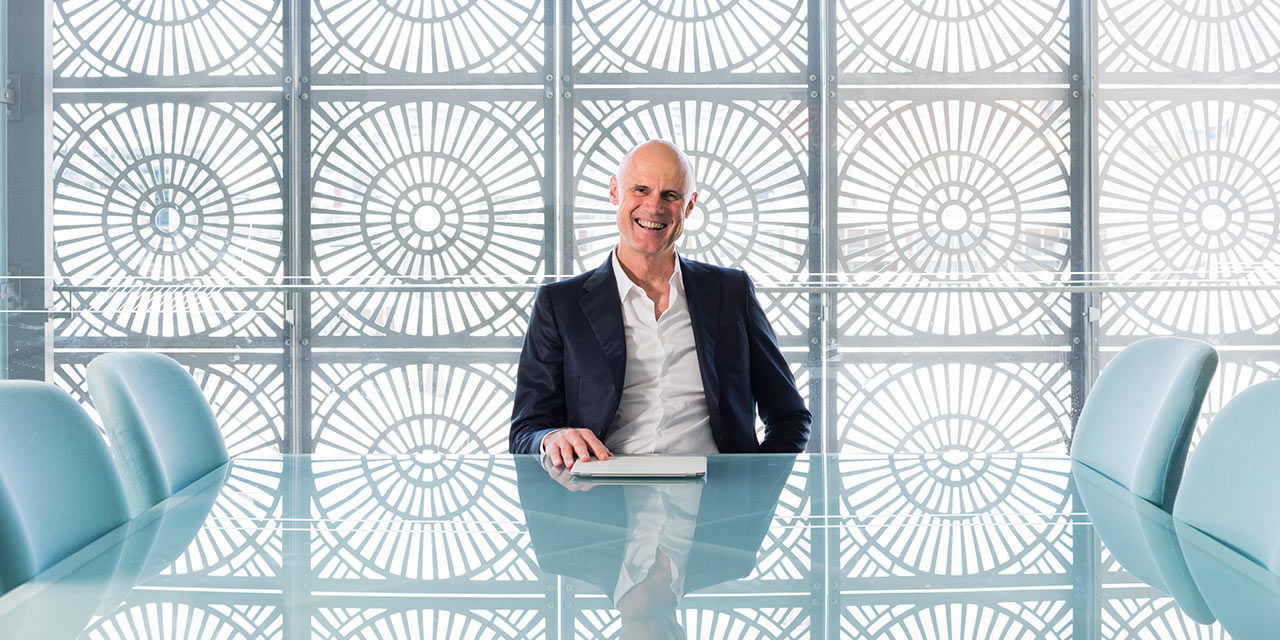
Phillip Mills
Executive director, Les Mills International
I don’t have a problem with a cycling class being entertaining. We are, after all, in the motivation business as much as we are in the fitness business. We have to make group exercise fun. At Les Mills, we’ve pushed entertainment to the max in our TRIP classes. Other brands like SoulCycle deliver entertainment through their lighting, their music, their excellent instructors, the great presentation of their classes.
But I do have an important observation. We’ve developed three cycling classes at Les Mills over the years – RPM, SPRINT and THE TRIP – and that’s because people like cycling. You don’t have to add other exercises to it. Give people the essence of what it is they’ve come to you for. Give them the best feeling of cycling you can, then encourage them to take part in other modalities separately so they enjoy the best possible feeling of those too.
Integrating light hand weights into a cycling class, for example… If that’s the only class you ever do, you might like the fact it includes a bit of upper body, but realistically you’ll get far more benefit and far more enjoyment from doing weights in a different format – in the gym, for example, or a BODYPUMP class. The same goes for other modalities. You don’t have to mix everything up in one class.
I also have questions about some of the choreography I see out there – all that standing in the pedals and sprinting. I think majoring on that sort of choreography actually narrows your audience, because it’s very hard for most people to do. It also comes with an injury risk.
In our classes, if you’re standing in the pedals, you’re doing a hill climb: slow, high resistance, working legs, glutes and core. Sprinting is done in the saddle, where people are able to do it – and do it safely. This, we believe, is the way to maximise the benefits.
For me, then, it isn’t about form versus content, style versus substance. You do want both – but first and foremost you need to get your content right.
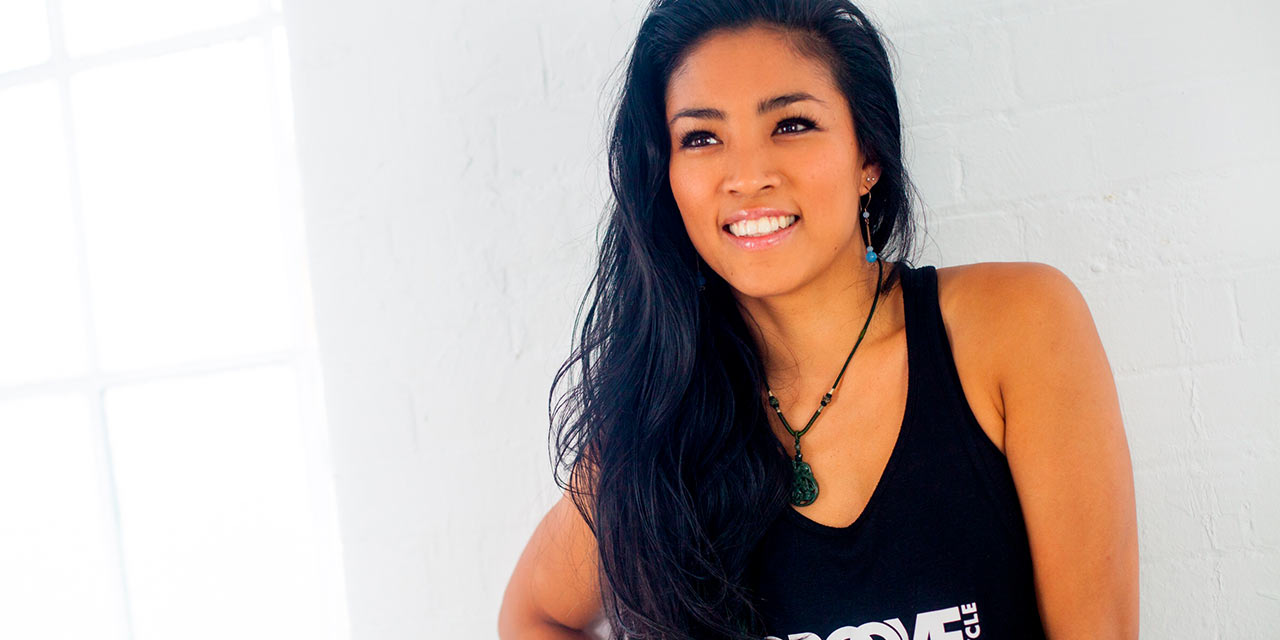
Sarah-Jane (SJ) Aboboto
Creator & founder, GrooveCycle
As a professional dancer, indoor cycling was never on my radar. Moving while getting lost in the music was my way of staying healthy and active.
That changed when I experienced my first SoulCycle class, where the music and what I was doing on the bike were so well linked. Riding in sync with the music, going through waves of different emotions, I got a similar feeling to when I danced – and in turn, that encouraged me to work harder.
And music is a motivator for many people. When accompanied with good planning and coaching, the right music choices play a significant role in getting riders into the red and yellow ‘performance’ heart rate zones without even realising it. By which I’m trying to say, rhythm classes don’t mean you won’t get results. Instructors just have to keep their skills sharpened so they always deliver the best possible experience, the best journey, for their style of class.
With this thought in mind, I created GrooveCycle, which offers two styles of rhythm cycling. My main purpose: to get more people to be active, feel good, release their stresses and have fun – all in a safe environment that’s focused on preventing injuries and avoiding excessive workload. But interestingly, we’ve found it appeals to a very mixed audience: not only people who previously felt indoor cycling wasn’t for them, but also avid outdoor cyclists and regular indoor cyclists.
Nevertheless, I had a mixed bag of opinion: some people loved the creativity and fresh approach to exercise; others resisted it, saying it was more style over substance. But those who actually tried a class tended to come back for more. Why? Because we deliver a great balance between style and substance: an awesome experience and a great workout.
In fact, I’ve come to appreciate data and performance riding in my other role as Stages master educator, and I firmly believe you can connect and combine the two worlds. Rather than seeing rhythm as style and performance as substance, both can work together to boost motivation and effort levels, so riders see and feel the results.
Geoff Bamber
Founder & CEO, Digme Fitness
The group fitness market generally, and the cycling studio market specifically, have grown hugely over the last few years. It’s therefore inevitable that competitors are looking for ways to differentiate their brands, but it’s important to do so carefully.
Cycling is a wonderful, accessible form of group exercise, but like most forms of exercise it can be compromised by poor instruction or programming that – in an attempt to be fun or cool – renders it less safe or less effective.
Our view: it’s not fun or cool to be injured! The coolest kind of exercise is the kind you go back to time and again, getting fitter each time, and that can be done safely, without risk of injury.
That’s why, although community and fun are key to our offering at Digme, we believe the workout is king. Our focus is always on giving people a safe, authentic, effective workout. We believe authenticity and safety are under-rated qualities in cycling classes: we never instruct movements or pedal speeds that we believe to be unsafe.
And then effective: this is really key for us and why, going back to the topic being discussed, we’re confident in the ‘substance’ of our classes.
We have a series of signature Perform workouts, for example, which engage with more technical concepts such as Functional Threshold Power to customise workouts to the individual, making them tough but inclusive. We use in-class technology to periodically drop in challenges, motivating customers to really push themselves. And we gather highly accurate data from our bikes, so riders receive meaningful feedback and can track real, tangible progress – even before it’s visible physically.
Hilary Rowland
Co-founder, Boom Cycle
Funnily enough, since day one we’ve always said we were ‘substance over style’. In part, this is down to our fit-outs, which are nice but without over-spending on being really flashy. We focus most of our efforts and energy on the product itself: the class content and delivery.
A Boom Cycle ride is a metric- free, party-on-a-bike style experience that focuses on bringing escapism to riders’ busy lives – but it’s also a workout that packs a punch.
Our rides are led by expert motivators, all of whom we have hand-picked via auditions and then intensively trained through a five- to six-week training programme called Boom-i-versity. This is a very challenging programme to ensure all our instructors bring the best possible experience to our riders.
In terms of the classes themselves, these have also been very carefully designed. They
feature simple moves that are easy to understand and follow, and everything is underpinned by keeping the core tight and the right amount of resistance on the bike. All moves (especially upper body) are executed within the back-to-forward plane only.
A Boom Cycle ride at its basic level is challenging, so riders are advised they can sit down and take a break whenever they want or need to.
Yet all of this is done in a way that’s inclusive and unpretentious. No numbers, no competition, just fun and high fives all round. With the lights low and a world-class sound system, we engage riders mentally as well as physically, immersing them in the ultimate ‘party on a bike’ experience and encouraging them to cut loose from their day and forget their stresses.
We’re proud to have created five thriving studios and a Boom’ing community in each of these.
A cast of thousands
“My initial ambition for Ørbike, back in 2014 when we ran the first event, was to raise money to buy equipment for our local fitness club,” says Jesper ‘JAS’ Sørensen, Ørbike organiser. “Beyond this, my dream – and my ultimate goal – has always been to raise money for charity, especially the Children’s Cancer Foundation. People like to participate in events that support charity, and as a result, Ørbike has raised €20,000 since the event began.”
The Ørbike concept – back-to-back indoor cycling classes for hundreds of people at a time, all led from the stage by top instructors to the backdrop of a pumping music soundtrack and great lighting – has proved very popular: in spite of taking place in the small town of Ørbæk, Ørbike has grown to become Denmark’s second largest indoor cycling event, taking place every November.
“The first year, we had 88 bikes for a six-hour event. That year was very hard. The breakthrough came when we entered into partnerships with sponsors – that’s the reason we’re still here today,” says Sørensen. “By the second year, we had already leapt up to 256 bikes, 10 hours of cycling, and all 256 tickets were sold out in two days.”
Fast-forward to 2019 and the event’s appeal shows no sign of waning: Ørbike 2019, which took place over 12 hours on Saturday 9 November, attracted a total of 1,500 participants. And that, of course, meant a lot of bikes – 272 BODY BIKES, to be precise.
“In addition to the five people in our core team, we had 150 volunteers involved in the preparation of the event: setting up the light, the show, the food, and gathering the bikes from fitness clubs across Denmark. We had 200 brand new SMART+ bikes from BODY BIKE and Fitness Engross, as well as another 72 BODY BIKE SMART+ which we borrowed from clubs around the country,” says Sørensen.
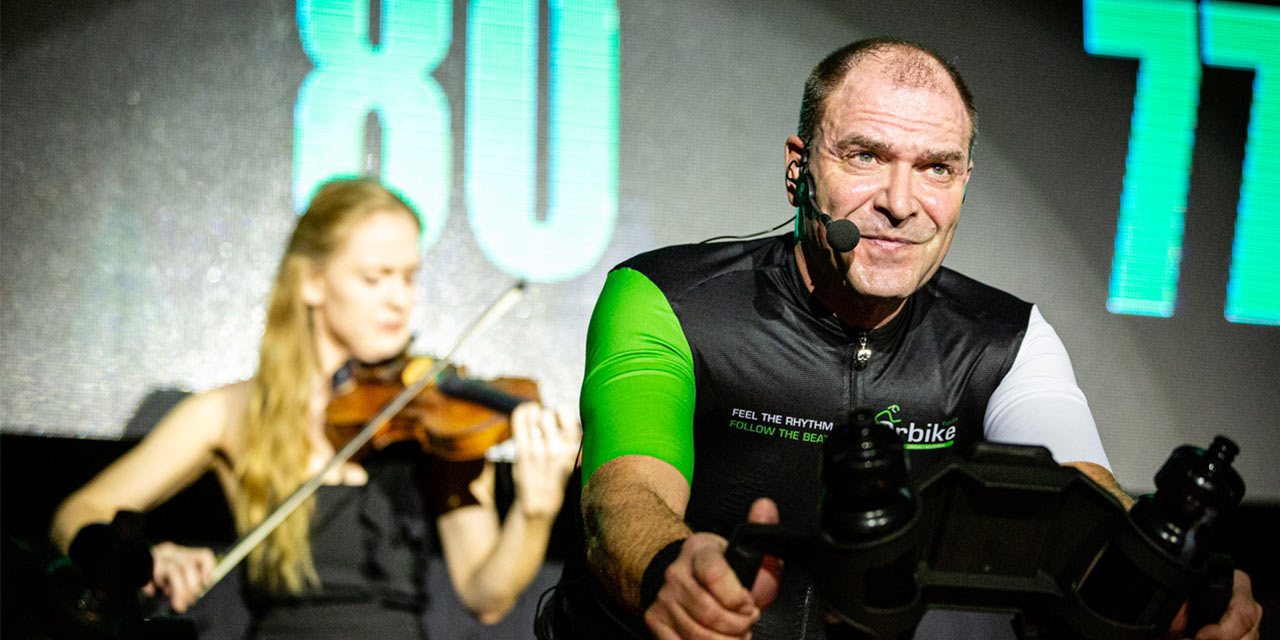
A star is born
“For me, the key ingredient to running a successful event such as this is that you must really believe in what you’re doing. You must go for it 110 per cent,” Sørensen continues. “It involves a lot of hard work and a continual drive to make improvements and refinements every year to stay at the top of your game.
“We won’t settle for anything other than the best when it comes to music, instructors,
set-up. People leave Ørbike on a real high, and it lasts for days.”
So, what does Sørensen look for in his Ørbike instructors – the 12 instructors needed for the 12 hours of performance? “For me, the key is the differences between the instructors: I need fun instructors, serious instructors, instructors who play different styles of music.”
Already on the road a lot as part of his day job – as a country sales manager for the cycling clothing brand Assos of Switzerland – Sørensen has the chance to pop in to health clubs and studios around the country. By participating in cycling classes wherever he goes, he effectively has the chance to ‘audition’ instructors to find the country’s best, who he can then invite to be involved in Ørbike.
He also believes Ørbike has space for both experienced and new instructors – what matters is your stage presence. “You can be the best instructor in your local centre, but not everyone has the presence to be on a big stage,” he explains. “I look for instructors who have experience from other events, but I also look for new names who I can help build up to become the new stars.”
And that’s possible because instructors are given free rein to bring their sessions to life at Ørbike, constrained only by their imagination. A great example comes from Sørensen himself, in his exciting session at this year’s event. Challenged by a friend who felt he only ever coached traditional cycling classes, Sørensen says: “I wanted to prove him wrong, so I delivered a circus-style session with ‘Circus JAS’ video footage up on the big screen and clowns cycling on the stage with me.
“I also invited a famous Danish violinist, Michella Høj, on-stage for the finale. I wanted to give it some real spice and for participants to get goosebumps.”
Social energiser
Participation at Ørbike can be as an individual or a group, with prices starting at €130 for a bike on the back row – you can then switch as many people in and out of the saddle as you choose throughout the 12 hours. Bikes in the front row cost €535 and are available only to businesses as part of a sponsorship package.
Bitten Kvist Jacobsen, a member at Struer Fitness, was one of the 1,500 participants at this year’s event. She comments: “Ørbike is very social. Every time I go, I make new friends. Everyone takes care of you – if you don’t know how to set up the bike, someone will help you – and everyone says ‘hi’.
“My friends at home aren’t really into indoor cycling – they don’t understand my ‘craziness’ about it – but at Ørbike I’m surrounded by people who share my interests and my passion. That’s why I love it. I also get new ideas that I can use in my own training at the gym. It’s invaluable workout inspiration.”
And that matters, because Jacobsen is a cycling aficionado, taking part in numerous indoor cycling classes every week. Why? For the feelgood buzz it gives her. “Every time I go to a cycling class, even when I’ve had a long working day, it feels good,” she explains. “This is ‘Bitten Time’. It improves my mood, making me happier. If I don’t get my exercise, my colleagues notice. They’ll say: ‘Bitten, you haven’t trained today!’”
So, does she not get tired after all those hours of cycling at Ørbike? “You can’t get to hour five without being a bit tired,” she acknowledges, “but the music gets your legs started. You sweat like crazy, but it’s pure joy and the music is so motivational.
“The instructors are fantastic too – so prepared. They get down off the stage and get us involved. I think my favourite session this year was probably hour number seven, instructed by Kim Lahn, because of the music and the energy – but I enjoyed every hour as a participant.”
Finally, the 1,499 other participants are another factor to take your mind off the pain. “At an event as big as Ørbike, there are so many people cheering you on,” says Jacobsen. “It’s such a great feeling. The spirit at the event really is so special.”
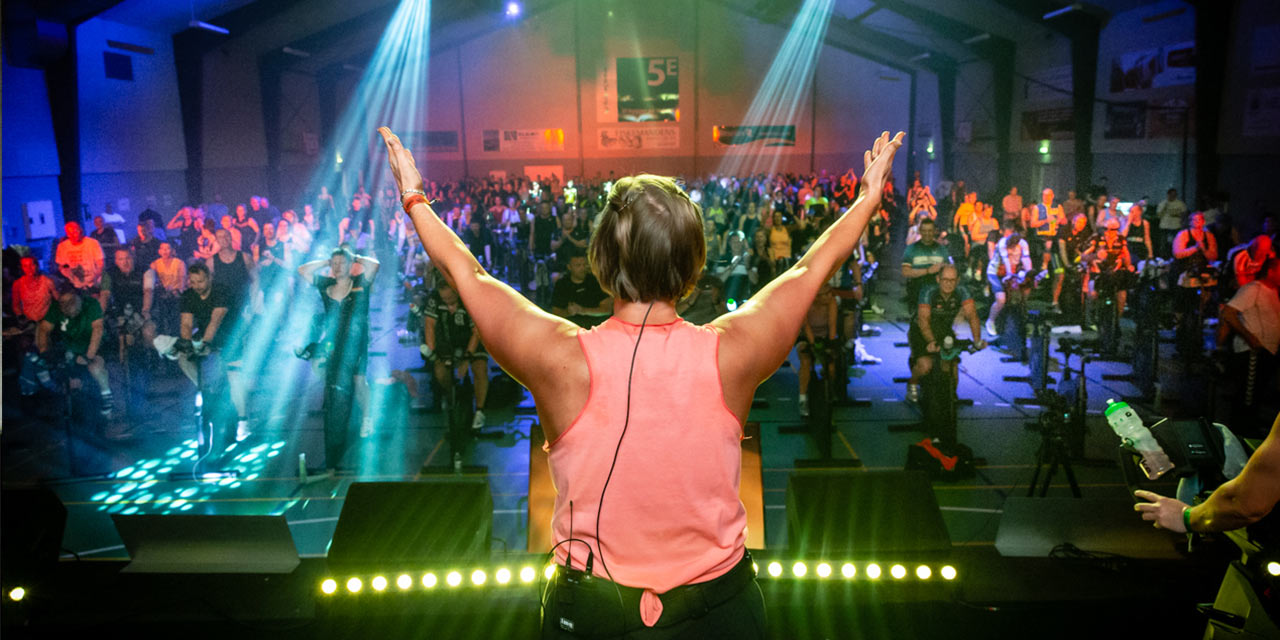 High expectations
High expectations
One of the instructors at Ørbike 2019 was Lene Lystrup from SATS Aalborg – an experienced instructor who was previously on the Ørbike stage three years ago, and who was delighted to be back. “For me as an instructor, it’s a really professional event,” she says. “The sound is great, the lighting is great. Everything is taken care of. All you have to do is perform.”
But perform the instructors must. “The expectations are high because all eyes are on you,” confirms Lystrup. “I do things quite differently from the way I instruct in a normal class. I use myself a bit more – I put myself out there to ensure I connect with everyone, and I really focus on telling everyone how great they are. They then give me love back and really get into the zone, and they end up buzzing and on a real high.”
Well known for her music, Lystrup spends around 100 hours preparing her programme for Ørbike. “Music is the key for me, but you have to use it in the right way to create a flow,” she says. “It’s a feeling I can’t really describe, but the feedback I get from participants is that mine are always happy, sing-along sessions.
“Figuring that people were more likely to start singing at an event than in a normal class, I therefore decided to go all-in and create a karaoke cycling session for this year’s Ørbike! I wanted everyone to come out thinking: ‘Wow, that was like a Friday night out with my friends.’”
Indeed, although participants benefit from the training at Ørbike, and instructors in the audience are there to pick up ideas, Lystrup feels the social aspect is even more important at events such as this: “I know some people will be training using the colour-coded effort zones on the BODY BIKES, but honestly – for me, the most important thing is that people are having a party.”
Lystrup also added a personal touch this year, taking her best friend on-stage to cycle next to her. “She’s lost 60lbs by cycling. It’s such a wonderful story, I was worried I was going to cry when she was with me on the stage,” says an emotional Lystrup.
When you consider all of this – the personal touches and the 100 hours of prep work – it’s clear Ørbike has a special place in Lystrup’s heart. “It does,” she agrees, “because five years ago, Jesper took a chance and believed in me, inviting me to get involved. There wouldn’t be an Ørbike without Jesper – he’s the one who sets the whole vibe.
“I also love that he and his team listen to the instructors and the participants. They take on-board all the feedback and make changes were needed. For example, this year we had 272 BODY BIKES. When everyone has the same bike, it makes the whole thing more professional.
“The feeling in the room is electric and you want to keep coming back for more. I can’t wait for next time.”

